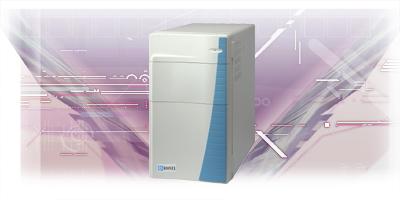|
Instrument Database:
Dionex Corporation - Summit LC/MS System
| |
|

|
| |
|
| |
|
| Year of introduction |
|
| Status |
available |
| Company |
Dionex Corporation
|
| Categories |
Chromatography: LC/HPLC
Hyphenated Techniques: LC-MS
Mass spectrometer: LC-MS
|
|
Do you believe LC-MS is still a complicated and difficult-to-handle technique? This is not the case with the Summit® LC/MS system. The Summit System Wellness technology, automatic calibration of the MS detector, and a self-cleaning ion source allow for continuous routine operation without the need for frequent cleaning or maintenance. The complete system is easy to use, requiring very little setup or tuning to achieve optimum sensitivity. And you no longer have to learn two software packages to operate your LC/MS system. Chromeleon® LC/MS software provides single-software method setup and instrument control, powerful UV and MS data analysis, and fully integrated reporting. See the "Relates Stories" to the right for additional information about the components of the Summit LC/MS system, including the MSQTM Mass Spectrometric Detector, analytical Summit HPLC System, and Chromeleon Chromatography Management System. | |  | Little Space Required
Have more space in your laboratory with modern compact instruments. A complete Summit LC/MS system is less than 80 cm (31 in.) wide, and is by far the most compact LC/MS system on the market today. The integrated design of the MSQ TM detector has led to an approximate twofold decrease in footprint area and system volume compared to previous MS systems, with no compromise in system performance. On the contrary, design changes have been implemented that significantly increase performance and functionality. |  | Performance
Reliably detect trace-amount components with the most sensitive single quadrupole LC/MS system available. The MSQ M Path TM triple orthogonal source virtually eliminates neutral noise and background, assuring extreme sensitivity from real samples. The Summit HPLC system ensures the stable operating conditions required for continuous high-ionization yields. Furthermore, with a Summit LC/MS system you do not need to reinvent the wheel. The MSQ is compatible with existing LC methods, especially those including salts, ion-pairing agents, and dirty matrices, and can be operated over a wide range of conditions, including flow rates up to 2 mL/min. |  | Robustness and Reliability
The Summit LC/MS system with the MSQ Mass Spectrometric Detector is extremely robust and reliable, allowing routine operation over extended periods, even in unattended mode. The self-cleaning atmospheric pressure ionization (API) source ensures continuous high sensitivity without the need for frequent cleaning, even when using inorganic buffers or ion-paring agents. Summit System Wellness technology ensures that the HPLC instruments continuously perform under optimal conditions. Warnings are automatically generated if one of the HPLC modules detects a problem, thereby preventing wasted resources from unconsciously running the system under suboptimal conditions. |  | Maximum Flexibility
With the Summit LC/MS system, you have flexibility with respect to supported MS techniques and required flow conditions. The MSQ comes with atmospheric pressure ionization (API), with both electrospray ionization (ESI) and atmospheric chemical ionization (APCI) capabilities. The system can switch source polarity for the analysis of both positive and negative ions or change the cone voltage (collisional induced fragmentation) on sequential scans across a chromatographic peak. The Summit HPLC pump can be optimized, within minutes, for the lowest gradient delay volume and superior mixing. When operating your system at low flow rates (<200 µL/min), lowest gradient delay optimization considerably reduces your analysis times, and therefore improves the total throughput of your system. When using ion-paring agents or poorly miscible eluents, superior mixing optimization increases the sensitivity of your system. |  | More Information in Less Time
As an LC/MS user, you spend a considerable amount of your time with data analysis and reporting. Chromeleon LC/MS software is the most intuitive and most powerful chromatography software package on the market, and allows you to extract more information from your data, in less time. It provides fully integrated LC/MS method and instrument control, fast comparisons and extraction, background correction of mass and UV spectra, and Microsoft Excel-type reporting for data from all detectors. You spend less time on learning new software, so you have more time for your analytical work. |
|
| Specifications |
|
| Summit LC/MS System Specifications | | P680 pumps | Settable flow range
Binary HPG: 1–10,000 µL/min
Quaternary LPG: 1–10,000 µL/min Flow accuracy and precision
± 0.1% at 1 mL/min Gradient delay volume (with microflow kit)
Binary HPG: <70 µL
Quaternary LPG: <300 µL | | Vacuum degassers | Quaternary LPG: built-in; 4 channels
Other versions: external (optional) | | ASI-100 Autosampler | Sample capacity
Micro tray segments: 192 1.2-mL vials
Analytical tray segments: 117 2-mL vials
Semipreparative tray segments: 63 4-mL vials Injection volume
0.1–250 µL Precision
5–100 µL injections: typically <0.2% RSD
1–5 µL injections: typically <1% RSD Thermostatted version
Temperature range: Settable from 4–45 °C | | TCC-100 Thermostatted Column Compartment | Temperature range: 5–85 °C
Temperature accuracy: ±0.5 °C
Temperature stability: ±0.1 °C
Temperature precision: ±0.1 °C
Cooling/heating performance: Less than 20 min from 20 to 50 °C | | UVD 170U 4-channel UV-Vis detector | Wavelength range: 200–595 nm
Noise: ±5 µAU, 254 nm
Signals: Up to 4 wavelengths
The detector is upgradeable to the photodiode array version UVD 340U | | UVD 340U Photodiode Array Detector | Wavelength range: 200–595 nm
Noise: ± 5 µAU, 254 nm
Spectral resolution: 1.9 nm (UV), 3.3 nm (Vis) | | PDA-100 Photodiode Array Detector | Wavelength range: 190–800 nm
Noise: ±10 µAU, 254 nm
Spectral resolution: 1 nm
Lamps: deuterium and tungsten | | MSQ Mass Spectrometric Detector | Mass range:
Standard version: 50–2000 Da
With enhanced low–mass option (ELMO): 18–1500 Da Sensitivity:
Positive ion ESI (50 pg erythromycin inj.): 1000:1 signal-to-noise
Negative ion ESI (20 pg p -nitrophenol inj.): 500:1 signal-to-noise
Positive ion APCI (50 pg erythromycin inj.): 200:1 signal-to-noise
Negative ion APCI (20 pg p -nitrophenol inj.): 50:1 signal-to-noise |
|
|